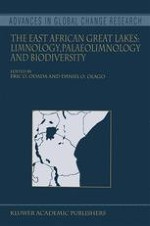2002 | OriginalPaper | Buchkapitel
Application of Satellite AVHRR to Water Balance, Mixing Dynamics, and the Chemistry of Lake Edward, East Africa
verfasst von : John T. Lehman
Erschienen in: The East African Great Lakes: Limnology, Palaeolimnology and Biodiversity
Verlag: Springer Netherlands
Enthalten in: Professional Book Archive
Aktivieren Sie unsere intelligente Suche, um passende Fachinhalte oder Patente zu finden.
Wählen Sie Textabschnitte aus um mit Künstlicher Intelligenz passenden Patente zu finden. powered by
Markieren Sie Textabschnitte, um KI-gestützt weitere passende Inhalte zu finden. powered by
Surface heat balance and evaporation rates for Lake Edward were calculated as part of a model for mixed layer dynamics. Evaporation rates were combined with rainfall and fluvial income to estimate water balance. Heat and water balance were subjected to sensitivity analyses to evaluate the relative effects of variations in minimum and maximum air temperature, humidity, wind speed, cloud cover, and rainfall. Cloud cover and wind speed emerged as the most influential factors for lake temperature, evaporation, and mixing dynamics Historical variations in ionic strength of Lake Edward surface water underscore sensitivity of the lake to climate. Major ion composition of the lake is incongruous with chemical inputs reported for streams descending from the Ruwenzoris and the highlands of southwestern Uganda. Mass balance calculations reveal that major sources of many elements are unaccounted for by present measurements, and point to the dominance of as yet unstudied stream sources entering the lake from the Virunga volcano region at the south. Based on model calculations, the chemical composition of water sources from the Virunga region is predicted a priori. Lake Edward is remarkable because despite episodic richness of biogenic Si in its sediments, diatoms are not common at present, although they are more prevalent in the south than in the north. One reason for episodic success by diatoms may be linked to changing patterns of lake mixing. Seasonal mixing dynamics of the lake were inferred from weather records and radiation flux measured from Advanced Very High Resolution Radiometer (AVHRR) satellite data. SSTs inferred from AVHRR imagery were used to test one hypothesis for the diatom distribution- namely that increased water column stability in the north and a shoaling mixed layer exaggerate the loss rates by sinking and depress the supply of nutrients from below. Variations in water balance for the lake are consistent with observations of significant changes in lake water chemistry during the 20th century.
